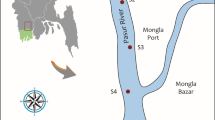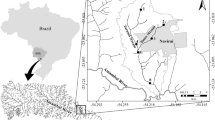Abstract
The environmental exposure to As, Se, Hg, Pb, Cr and toxaphene was assessed for 11 freshwater fish species in irrigation channels, agricultural return flow drains, a drain collecting lagoon and sections of the Colorado River at the Mexicali valley in Baja California, México, during August 2015–April 2016. Arsenic (2.90 ng ml−1) and Se (1.41 ng ml−1) in water had the highest concentrations in the return flow drains (Hardy River and Xochimilco Lagoon, respectively). However, fish axial muscle tissue had the highest concentration of Se (8.3 µg g−1) and Hg (0.36 µg g−1) in Colorado River fresh water, while As (1.7 µg g−1) in Hardy River fish was highest. Selenium concentrations in all fishes and toxaphene in Cyprinus carpio and Ameiurus natalis are above the safe levels for human consumption (0.3 µg g−1 and 180 ng g−1 respectively). Toxaphene was detected in the fish axial tissue, having the highest concentrations in Poecilia latipinna (690 ng g−1) in the Colorado River. The low proportion of the 8-Cl toxaphene congeners in fish suggests degradation of this pollutant. Tilapia. sp. cf. zillii had the most genotoxic damage with 7.4 micronucleated erythrocytes per 10,000 erythrocytes in Xochimilco Lagoon and 2 in Hardy River. The genotoxicity in all the fish species studied was significantly correlated to the concentrations of As and Se in water.




Similar content being viewed by others
References
Ahmed K, Habibullah-Al-Mamun AH, Mohammad A, Parvin E, Akter MS, Khan MS, Islam M (2011) Assessing the genotoxic potentials of arsenic in tilapia (Oreochromis mossambicus) using alkaline comet assay and micronucleus test. Chemosphere 84:143–149. https://doi.org/10.1016/j.chemosphere.2011.02.025
Al-Sabti K (1986) Clastogenic effects of five carcinogenicmutagenic chemicals on the cells of the common carp (Cyprinus carpio L). Comp Biochem Physiol 85C:5–9. https://doi.org/10.1016/0742-8413(86)90043-5
AI-Sabti K (1994) Micronuclei induced by selenium, mercury, methylmercury and their mixtures in binucleated blocked fish erythrocyte cells. Mutat Res 320:157–163. https://doi.org/10.1016/0165-1218(94)90068-x
Anscombe FJ (1948) The transformation of Poisson, binomial, and negative binomial data. Biometrika 35:246–254
Arellano-García ME (2010) Genotoxicidad por exposición a mezclas de contaminantes en residentes próximos al río Hardy-Colorado, Baja California. Ph.D. thesis, Universidad Autónoma de Baja California, p 179
Arcaro KF, Yang Y, Vakharia DD (2000) Toxaphene is antiestrogenic in a human breast-cancer cell assay. J Toxicol Environ Health A 59:197–210. https://doi.org/10.1080/009841000156970
Ayllon F, Garcia-Vazquez E (2000) Induction of micronuclei and other nuclear abnormalities in European minnow Phoxinus phoxinus and mollie Poecilia latipinna: an assessment of the fish micronucleus test. Mutat Res 467:177–186. https://doi.org/10.1016/S1383-5718(00)00033-4
Braham RP, Blazer VS, Shaw CH, Mazik PM (2017) Micronuclei and other erythrocyte nuclear abnormalities in fishes from the Great Lakes Basin USA. Environ Mol Mutagen 58:570–581. https://doi.org/10.1002/em.22123
Bosch AC, O’Neill B, Sigge GO, Kerwath SE, Hoffman LC (2016) Heavy metals in marine fish meat and human health: a review. J Sci Food Agric 96:32–48. https://doi.org/10.1002/jsfa.7360
Carpenter DO (2013) Effects of persistent and bioactive organic pollutants on human health. John Wiley & Sons, Inc Hoboken, New Jersey, p 608. https://doi.org/10.1002/9781118679654.index
Cavas T (2008) In vivo genotoxicity of mercury chloride and lead acetate: Micronucleus test on acridine orange stained fish cells. Food Chem Toxicol 46:352–358. https://doi.org/10.1016/j.fct.2007.08.015
Daesslé LW, Lugo-Ibarra KC, Tobschall HJ, Melo M, Gutiérrez-Galindo EA, García-Hernández J, Álvarez LG (2009) Accumulation of As, Pb, and Cu associated with the recent sedimentary processes in the Colorado Delta, South of the United States-México Boundary. Arch Environ Contam Toxicol 56:680–692. https://doi.org/10.1007/s00244-008-9218-2
DOF (2011) Norma Oficial Mexicana NOM-242-SSA1-2009, productos de la pesca frescos, refrigerados, congelados y procesados. Diarío Oficial de la Federación. http://dof.gob.mx/nota_detalle.php?codigo=5177531&fecha=10/02/2011
Ekici P, Friess A, Parlar H (2008) Permissible level of toxaphene residues in fish from the German market based on in vivo and in vitro effects to tumor promotion. Food Chem Toxicol 46:2320–2325. https://doi.org/10.1016/j.fct.2008.03.011
Ergene S, Cavas T, Celik A, Köleli N, Kaya F, Karahan A (2007) Monitoring of nuclear abnormalities in peripheral erythrocytes of three fish species from the Göksu Delta (Turkey): genotoxic damage in relation to water pollution. Ecotoxicol 16:385–391. http://dof.gob.mx/10.1007/s10646-007-0142-4
Flores-Galván M, Arellano-García E, Ruiz-Campos G, Daesslé LW (2017) Genotoxic assessment of some inorganic compounds in desert pupfish (Cyprinodon macularius) in the evaporation pond from a geothermal plant. Bull Environ Contam Toxicol 99:218–223. http://dof.gob.mx/10.1007/s00128-017-2114-6
García-Hernández J (2004) Water quality in the Colorado River Delta. Southwest Hydrol 3:18–19
García-Hernández J, Sapozhnikova YV, Schlenk D, Mason AZ, Hinojosa-Huerta O, Rivera-Díaz JJ, Ramos-Delgado NA, Sánchez-Bon G (2006) Concentration of contaminants in breeding birds eggs from the Colorado River Delta. Environ Toxicol Chem 25(6):1640–1647. https://doi.org/10.1897/05-185R.1
García-Hernández J, Glenn EP, Flessa K (2013) Identification of chemicals of potential concern (COPECs) in anthropogenic wet lands of the Colorado River delta. Ecol Eng 59:52–60. https://doi.org/10.1016/j.ecoleng.2013.04.045
Gutiérrez-Galindo EA, Flores-Muñoz G, Aguilar-Flores A (1988a) Mercury in fresh-water fish and clams from the Cerro Prieto geotermal field of Baja California, México. Bull Environ Contam Toxicol 41:201–207. https://doi.org/10.1007/BF01705431
Gutiérrez-Galindo EA, Flores-Muñoz G, Celaya-Villaescusa J (1988b) Chlorinated hydrocarbons in molluscs of the Mexicali Valley and upper Gulf of California. Cienc Mar 14:91–113. https://doi.org/10.7773/cm.v14i3.599
Gutiérrez-Galindo EA, Flores-Muñoz G, Villa-Andrade M, Villaescusa-Celaya JA (1998) Organochlorine insecticides in fishes from the Mexicali Valley, Baja California, México. Cienc Mar 14:1–22. https://doi.org/10.7773/cm.v14i4.618
Hinck JE, Blazer VS, Denslow ND, Echols KR, Gross TS, May TW, Anderson PJ, Coyle JJ, Tillitt DE (2007) Chemical contaminants, health indicators, and reproductive biomarker responses in fish from the Colorado River and its tributaries. Sci Tot Environ 378:376–402. https://doi.org/10.1016/j.scitotenv.2007.02.032
Jantunen L, Bidleman T (1998) Organochlorine pesticides and enantiomers of chiral pesticides in Arctic Ocean water. Arch Environ Contam Toxicol 35:218. https://doi.org/10.1007/s002449900370
Korytár P, Van Stee PLL, Leonards PE, De Boer J, Brinkman UA (2003) Attempt to unravel the composition of toxaphene by comprehensive two-dimensional gas chromatography with selective detection. J Chromatogr A 994:179–189. https://doi.org/10.1016/S0021-9673(03)00438-2
Kucuksezgin FA, Kontas O, Altay E, Uluturhan DE (2006) Assessment of marine pollution in Izmir Bay; Nutrient heavy metal and total hydrocarbon concentrations. Environ Int 32:41–51. https://doi.org/10.1016/j.envint.2005.04.007
Leonards EGP, Besselink H, Klungsøyr J, McHugh B, Nixon E, Rimkus GG, Brouwer A, De Boer J (2011) Toxicological risks to humans of toxaphene residues in fish. Integr Environ Assess Manag 8:523–529. https://doi.org/10.1002/ieam.1275
Lugo-Ibarra KC, Daesslé LW, Macías-Zamora JV, Ramírez-Álvarez N (2011) Persistent organic pollutants associated to water fluxes and sedimentary processes in the Colorado River delta, Baja California, México. Chemosphere 85:210–217. https://doi.org/10.1016/j.chemosphere.2011.06.030
Medina-Garza H (2012). Uso de biomarcadores en peces como herramienta para evaluarla exposición y efecto de contaminantes en cuerpos de agua. Master’s thesis. Universidad Autónoma de San Luis Potosí, Facultad de Ciencias Químicas, Ingeniería y Medicina, Programas Multidisciplinarios en Ciencias Ambientales, p 78
Mora MA, Anderson DW (1995) Selenium, boron, and heavy metals in birds from the Mexicali valley, Baja California, México. Bull Environ Contam Toxicol 54:198–206. https://doi.org/10.1007/BF00197431
Nolan BT, Clark ML (1997) Selenium in irrigated agricultural areas of the western United States. J Environ Qual 26:849–857. https://doi.org/10.2134/jeq1997.00472425002600030035x
Obiakor MO, Okonkwo JC, Nnabude PC, Ezeonyejiaku CD (2012) Ecogenotoxicology: micronucleus assay in fish erythrocytes as in situ aquatic pollution biomarker: a review. J Anim Sci Adv 2(1):123–133
Oost R, Beyer R, Vermeulen NP (2003) Fish bioaccumulation and biomarkers in environmental risk assessment: a review. Environ Toxicol Pharmacol 13(2):57–149. https://doi.org/10.1016/S1382-6689(02)00126-6
Romero S, García J, Valdez B, Vega M (2010) Calidad del Agua para Actividades Recreativas del Río Hardy en la Región Fronteriza México-Estados Unidos. Inf Tecnol 21:69–78. https://doi.org/10.4067/S0718-07642010000500010
Ruiz-Campos G, Camarena-Rosales F, González-Acosta AF, Maeda-Martínez AM, García de León FJ, Varela-Romero A, Andreu-Soler A (2014) Estatus actual de conservación de seis especies de peces dulceacuícolas de la Península de Baja California, México. Rev Mex Biodivers 85:1235–1248. https://doi.org/10.7550/rmb.43747
Sánchez-Osorio JL (2014) Plaguicidas organoclorados en suelos rurales, sedimentos y aire de zonas agrícolas del noroeste de México: fuentes y enantioselectividad. PhD thesis, Universidad Autónoma de Baja California, México, p 118
Schmid W (1975) The micronucleus test. Mutat Res 31:9–15. https://doi.org/10.1016/0165-1161(75)90058-8
Schrader T, Boyes B, Matula T, Héroux-Metcalf C, Langlois I, Downie R (1998) In vitro investigation of toxaphene genotoxicity in S. typhimurium and Chinese hamster V79 lung fibroblasts. Mutat Res. 413(2):159–168. https://doi.org/10.1016/S1383-5718(98)00027-8
Stapleton HM, Masterson C, Skubinna J, Ostrom P, Ostrom E, Baker JE (2001) Accumulation of Atmospheric and Sedimentary PCBs and Toxaphene in a Lake Michigan Food Web. Environ Sci Technol 35:3287–3293. https://doi.org/10.1021/es0019225
Steinel H, Arlauskas A, Baker RS (1990) SCE induction and cell-cycle delay by toxaphene. Mutat Res. 230(1):29–33. https://doi.org/10.1016/0027-5107(90)90038-6
South African Department of Health (DOH) (2004) Foodstuffs, cosmetics and disinfectants act, 1972 (Act no. 54 of 1972) Gov Gaz 500:4–6
Swackhamer DL, Pearson RF, Schottler S (1998) Air-water exchange of toxaphene in the Great Lakes. Chemosphere 37(9-12):2545–2561. https://doi.org/10.1016/S0045-6535(98)00307-5
Torres-Bugarín O, Zavala-Aguirre JL, Gómez-Rubio P, Buelna-Osbe HR, Zúñiga-González G, García-Ulloa Gómez M (2007) Especies de peces con potencial como bioindicadoras de genotoxicidad en el lago “La Alberca”, Michoacán, México. Hidrobiológica 17:75–81
USEPA (1999) Toxaphene update: impact on fish advisories, United States Environmental Protection Agency, Office of Water (4305), (EPA-823-F-99-018) Washington, D.C.
USEPA (2000) Guidance for assessing chemical contaminant data for use in fish advisories, vol 1: fish sampling and analysis, United States Environmental Protection Agency, Office of Science and Technology-Office of Water, (EPA-823-B-00-007) Washington, D.C.
Vetter W, Oehme M (2000) Toxaphene. Analysis and environmental fate of congeners. In: Paasivirta J (ed) New types of persistent halogenated compounds. The handbook of environmental chemistry/anthropogenic compounds. Springer-Verlag, Berlin, Heidelberg, p 237–287
Walters DM, Rosi‐Marshall E, Kennedy TA, Cross WF, Baxter CV (2015) Mercury and selenium accumulation in the Colorado River food web, Grand Canyon, USA. Environ Toxicol Chem 34:2385–2394. https://doi.org/10.1002/etc.30777
Zeng EY, Cherrie LV (1997) Organic pollutants in the coastal environment off San Diego, California. 1. Source identification and assessment by compositional indices of polycyclic aromatic hydrocarbons. Environ Toxicol Chem 16:179–188. https://doi.org/10.1002/etc.5620160212
Zúñiga G, Torres-Bugarín O, Ramírez-Muñoz MP, Ramos A, Fanti-Rodríguez E, Portilla E, García-Martínez D, Cantú JM, Gallegos-Arreola MP, Sánchez-Corona J (1996) Spontaneous micronuclei in peripheral blood erythrocytes from 35 mammalian species. Mutat Res 369:123–127. https://doi.org/10.1016/S0165-1218(96)90056-7
Acknowledgements
We are grateful to the Mexican Directorate for Wildlife (Dirección General de Vida Silvestre) for fish sampling permit SGPA/DGVS 09605/12 to GRC. The Mexican Council for Science and Technology CONACYT for granting a Ph.D. scholarship to MFG (368374).). Exotic Species Network of México (UANL-UABC-UMar) provided economic funds for this study. To K. Juárez (UNAM) for fluorescence microscopy training, L. Lares (CICESE) for allowing access to freeze-dry the fish tissue samples, T. Kretzschmar and E. Iñiguez (CeMIE-Geo/CICESE) for part of the water analyses, the group of the organic pollutants laboratory (IIO-UABC) for their support in extraction, analysis and interpretation of toxaphene. LWD acknowledges support by the Alexander von Humboldt Foundation while contributing to this paper at FAU.
Author information
Authors and Affiliations
Corresponding author
Ethics declarations
Conflict of interest
The authors declare that they have no conflict of interest.
Ethical approval
All applicable international, national, and/or institutional guidelines for the care and use of animals were followed. Fish sampling was approved by Mexican Directorate for Wildlife (permit: SGPA/DGVS 09605/12).
Additional information
Publisher’s note Springer Nature remains neutral with regard to jurisdictional claims in published maps and institutional affiliations.
Rights and permissions
About this article
Cite this article
Flores-Galván, M.A., Daesslé, L.W., Arellano-García, E. et al. Genotoxicity in fishes environmentally exposed to As, Se, Hg, Pb, Cr and toxaphene in the lower Colorado River basin, at Mexicali valley, Baja California, México. Ecotoxicology 29, 493–502 (2020). https://doi.org/10.1007/s10646-020-02200-9
Accepted:
Published:
Issue Date:
DOI: https://doi.org/10.1007/s10646-020-02200-9




